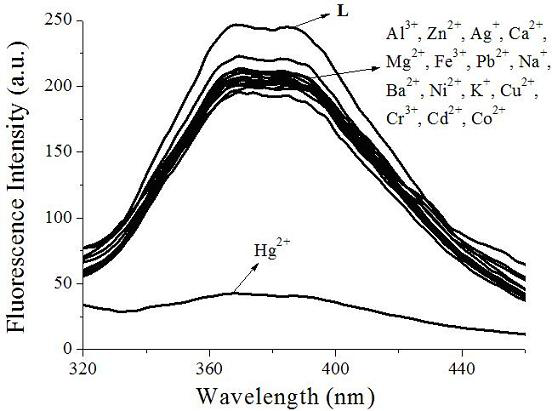hg based on imidazole derivative fluorescent probe 2+ and s 2- Relay fluorescence detection method
A technique of imidazole derivatives and fluorescent probes is applied in the field of establishment of a relay fluorescence detection method for mercury ions and sulfide ions, which can solve the problems of less fluorescent probes and the like.
- Summary
- Abstract
- Description
- Claims
- Application Information
AI Technical Summary
Problems solved by technology
Method used
Image
Examples
Embodiment 1
[0016] Use HEPES buffer solution with pH=7.4 as solvent, and the measured concentration is 1.0×10 –5 Fluorescence emission spectra of mol / L L solution for 16 common cations. Add 6.0 equiv. of 16 cations (Al 3+ , Zn 2+ , Ag + , Ca 2+ , Mg 2+ , Fe 3+ , Hg 2+ , Pb 2+ , Na + , Ba 2+ , Ni 2+ , K + , Cu 2+ , Cr 3+ , Cd 2+ , Co 2+ ) solution, only 6.0 equiv. Hg 2+ It can significantly quench L fluorescence, and the quenching range is 83%. In contrast, other metal ions caused only small changes. It shows that the fluorescent probe L of the present invention has an effect on Hg 2+ Features single-selection fluorescence detection. Where: the ordinate represents the fluorescence intensity, and the abscissa represents the fluorescence wavelength.
Embodiment 2
[0018] HEPES buffer solution with pH=7.4 was used as solvent, and different concentrations (0~11.0 equiv.) of Hg 2+ Join to 1.0 x 10 –5 mol / L L solution, observe the change results of its fluorescence emission spectrum. With Hg 2+ As the concentration increases, the fluorescence intensity of L at 370 nm decreases gradually. The above results show that the effect of L on Hg 2+ Has a high sensitivity. Where: the ordinate represents the fluorescence intensity, and the abscissa represents the fluorescence wavelength.
Embodiment 3
[0020] At a concentration of 1.0 x 10 –5 Add 12.0 equiv. of 15 kinds of cations (Al 3+ , Zn 2 + , Ag + , Ca 2+ , Mg 2+ , Fe 3+ , Pb 2+ , Na + , Ba 2+ , Ni 2+ , K + , Cu 2+ , Cr 3+ , Cd 2+ , Co 2+ ) solution, shake well and let stand for 5min, then add 6.0 equiv. Hg 2+ solution, shake well. Add 6.0 equiv. to L. The fluorescence intensity of the above 15 cations is close to that of L. When the above 15 cations and Hg 2+ coexist, and the cation concentration is Hg 2+ When the concentration is 2 times, it does not interfere with the effect of L on Hg 2+ detection, the system still has an obvious fluorescence quenching response, indicating that L has an effect on Hg 2+ The detection has excellent anti-interference performance and can be used as a detection method for Hg 2+ fluorescent quenching probes. Among them: the ordinate indicates the fluorescence intensity, the abscissa indicates the metal ion species, (0) blank, (1) Al 3+ , (2) Zn 2+ , (3) Ag + , (...
PUM
 Login to View More
Login to View More Abstract
Description
Claims
Application Information
 Login to View More
Login to View More - R&D
- Intellectual Property
- Life Sciences
- Materials
- Tech Scout
- Unparalleled Data Quality
- Higher Quality Content
- 60% Fewer Hallucinations
Browse by: Latest US Patents, China's latest patents, Technical Efficacy Thesaurus, Application Domain, Technology Topic, Popular Technical Reports.
© 2025 PatSnap. All rights reserved.Legal|Privacy policy|Modern Slavery Act Transparency Statement|Sitemap|About US| Contact US: help@patsnap.com



